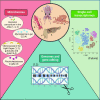Cephalopod-omics: Emerging Fields and Technologies in Cephalopod Biology
- PMID: 37370232
- PMCID: PMC10755191
- DOI: 10.1093/icb/icad087
Cephalopod-omics: Emerging Fields and Technologies in Cephalopod Biology
Abstract
Few animal groups can claim the level of wonder that cephalopods instill in the minds of researchers and the general public. Much of cephalopod biology, however, remains unexplored: the largest invertebrate brain, difficult husbandry conditions, and complex (meta-)genomes, among many other things, have hindered progress in addressing key questions. However, recent technological advancements in sequencing, imaging, and genetic manipulation have opened new avenues for exploring the biology of these extraordinary animals. The cephalopod molecular biology community is thus experiencing a large influx of researchers, emerging from different fields, accelerating the pace of research in this clade. In the first post-pandemic event at the Cephalopod International Advisory Council (CIAC) conference in April 2022, over 40 participants from all over the world met and discussed key challenges and perspectives for current cephalopod molecular biology and evolution. Our particular focus was on the fields of comparative and regulatory genomics, gene manipulation, single-cell transcriptomics, metagenomics, and microbial interactions. This article is a result of this joint effort, summarizing the latest insights from these emerging fields, their bottlenecks, and potential solutions. The article highlights the interdisciplinary nature of the cephalopod-omics community and provides an emphasis on continuous consolidation of efforts and collaboration in this rapidly evolving field.
© The Author(s) 2023. Published by Oxford University Press on behalf of the Society for Integrative and Comparative Biology.
Conflict of interest statement
The authors declare that there is no conflict of interest.
Figures
References
-
- Ahuja N, Hwaun E, Pungor JRet al. . 2023. Creation of an albino squid line by CRISPR-Cas9 and its application for in vivo functional imaging of neural activity. Curr Biol. S0960–9822: 00739–X..10.1016 - PubMed
-
- Albertin CB, Simakov O. 2020. Cephalopod biology: at the intersection between genomic and organismal novelties. Annu Rev Anim Biosci. 8: 71–90. - PubMed


